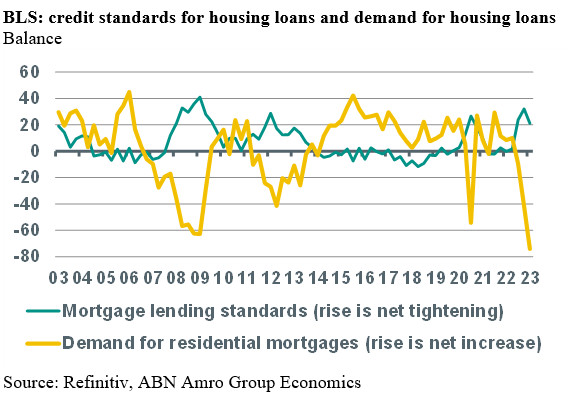Eurozone resilience won’t last

Eurozone Q4 GDP came in stronger than expected, expanding by 0.1% qoq, whereas a 0.1% qoq contraction was expected. However, there was weakness under the surface and we still expect GDP to contract moderately during most of 2023, as most of the impact of past and upcoming rate hikes, and the tightening in financial and bank lending conditions, is still very much to be felt on the economy. Indeed, further evidence of the negative impact of interest rate hikes by the ECB on the eurozone economy was provided by the latest ECB Bank Lending Survey (BLS), which showed that banks tightened credit standards for all types of loans in Q4, while loan demand collapsed.
Eurozone Q4 GDP: Higher than expected but weakness under the surface
Eurozone Q4 GDP came in stronger than expected, expanding by 0.1% qoq, whereas a 0.1% qoq contraction was expected. Eurostat has not yet published detailed data, but we can draw some conclusions about the strength and weaknesses from detailed data published by some of the bigger countries (i.e. France and Spain) and the written statements by other statistical offices (i.e. Germany and Italy). It appears that the volume of private consumption contracted sharply in Q4 and that fixed investment was weak as well (it contracted by 3.8% qoq in Spain and grew by 0.8% in France). Turning to the strengths in Q4, it seems that growth was mainly pushed higher by the contribution from net exports, which jumped higher due to a collapse in imports. Moreover, government consumption contributed positively to growth. Finally, there was a significant upward contribution to eurozone aggregate GDP from Ireland. Ireland has published its GDP numbers much earlier than it used to do and reported growth of 3.5% qoq, adding 0.1pps to the eurozone aggregate. So excluding Ireland eurozone GDP would have been flat.
Looking forward, we expect GDP to contract moderately during most of 2023. This will mainly result from monetary policy tightening by the main central banks, which will probably have a stronger downward impact on global growth this year, than the potential positive impact from China’s reopening. The impact of monetary policy tightening famously works with long and variable lags and we judge that most of the cumulative impact of past and upcoming rate hikes, and the tightening in financial and bank lending conditions, is still very much to be felt on the economy.

Banks’ credit standards tighten further
Indeed, further evidence of the negative impact of interest rate hikes by the ECB on the eurozone economy was provided by the latest ECB Bank Lending Survey (BLS) for 2022Q4. Banks tightened credit standards for loans to companies sharply again in Q4 (the net percentage of banks rose to 26 in Q4, up from 19 in Q3) and expect to tighten them again in 2023Q1. Moreover, the share of rejected applications for loans to firms increased (net percentage to 12, up from 8 in Q3). Banks also tightened credit standards on loans to households for house purchases and for consumer credit in Q4 and expect to tighten these further in Q1. Meanwhile, the BLS also showed that loan demand by companies and by households dropped lower in Q4. The net percentage decline in loan demand for house purchased dropped to its lowest level since the start of the series in 2003 (i.e. – 74%). Within loans, demand from companies, and demand for the purpose of fixed investment dropped the most (net percentage to -25 from -11). The drop in loan demand is in line with the declines in the flow of loans by MFIs to non-financial companies that was recorded in November and December (by almost EUR -20bn in total). All in all the results form the BLS support our view that the eurozone economy will contract in the coming quarters.
